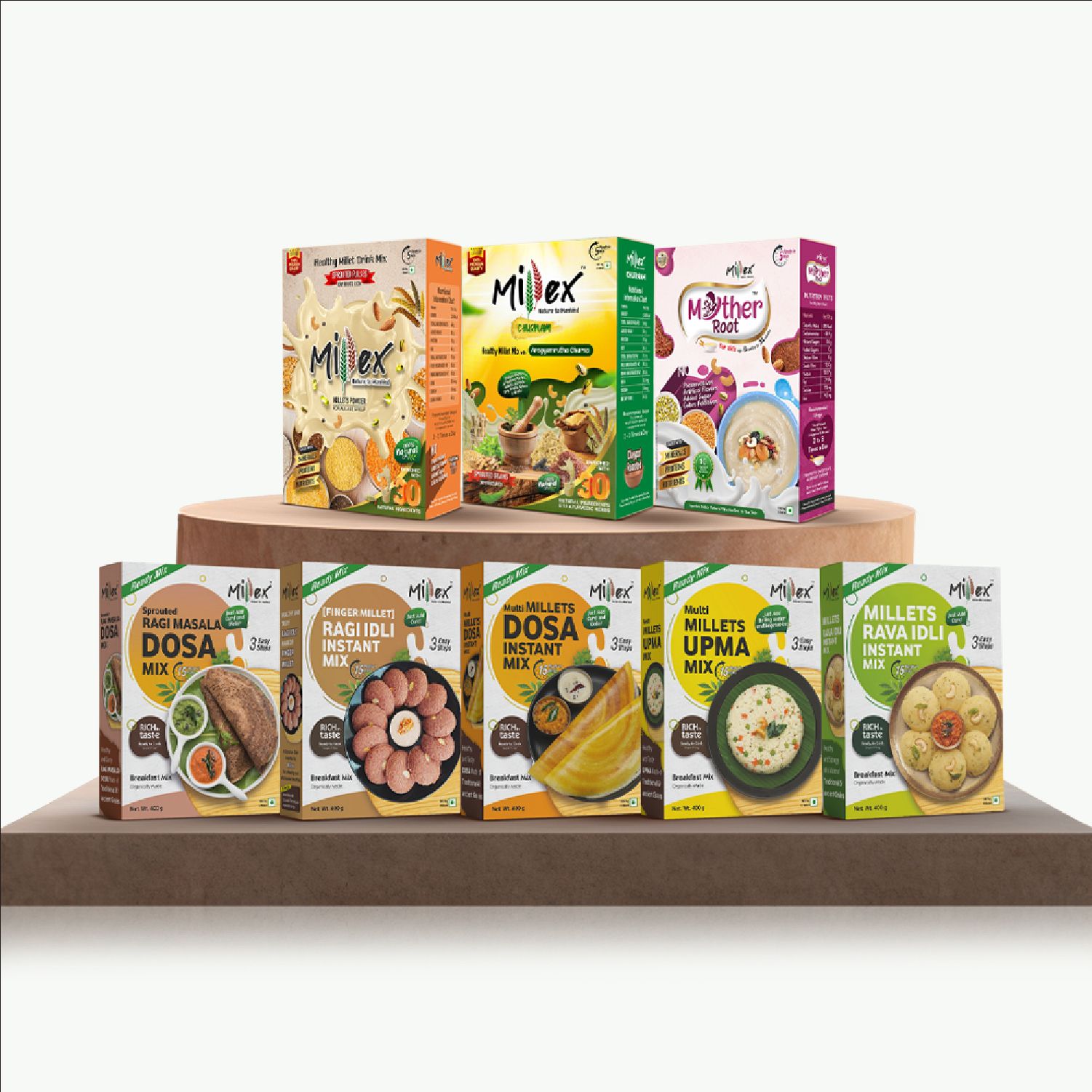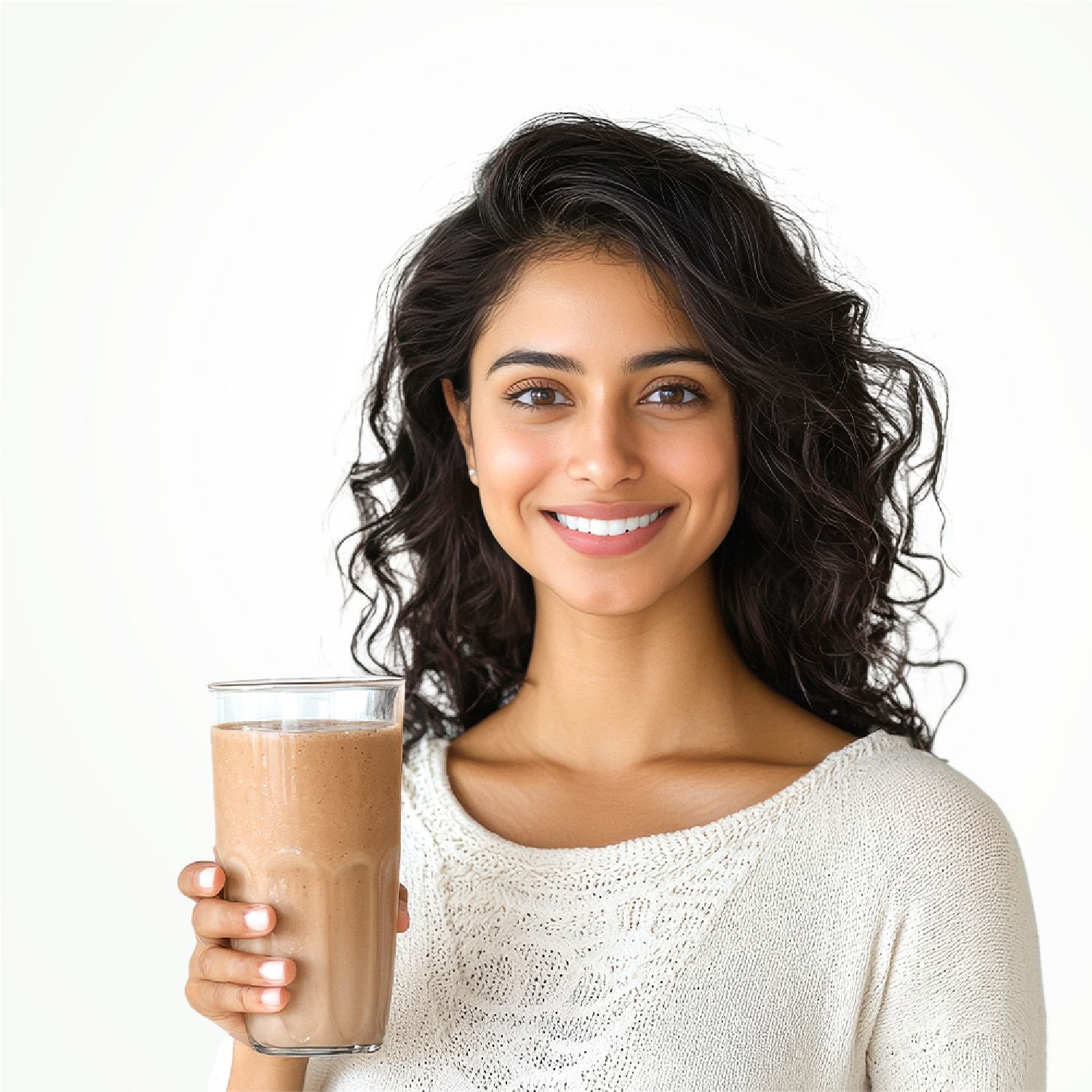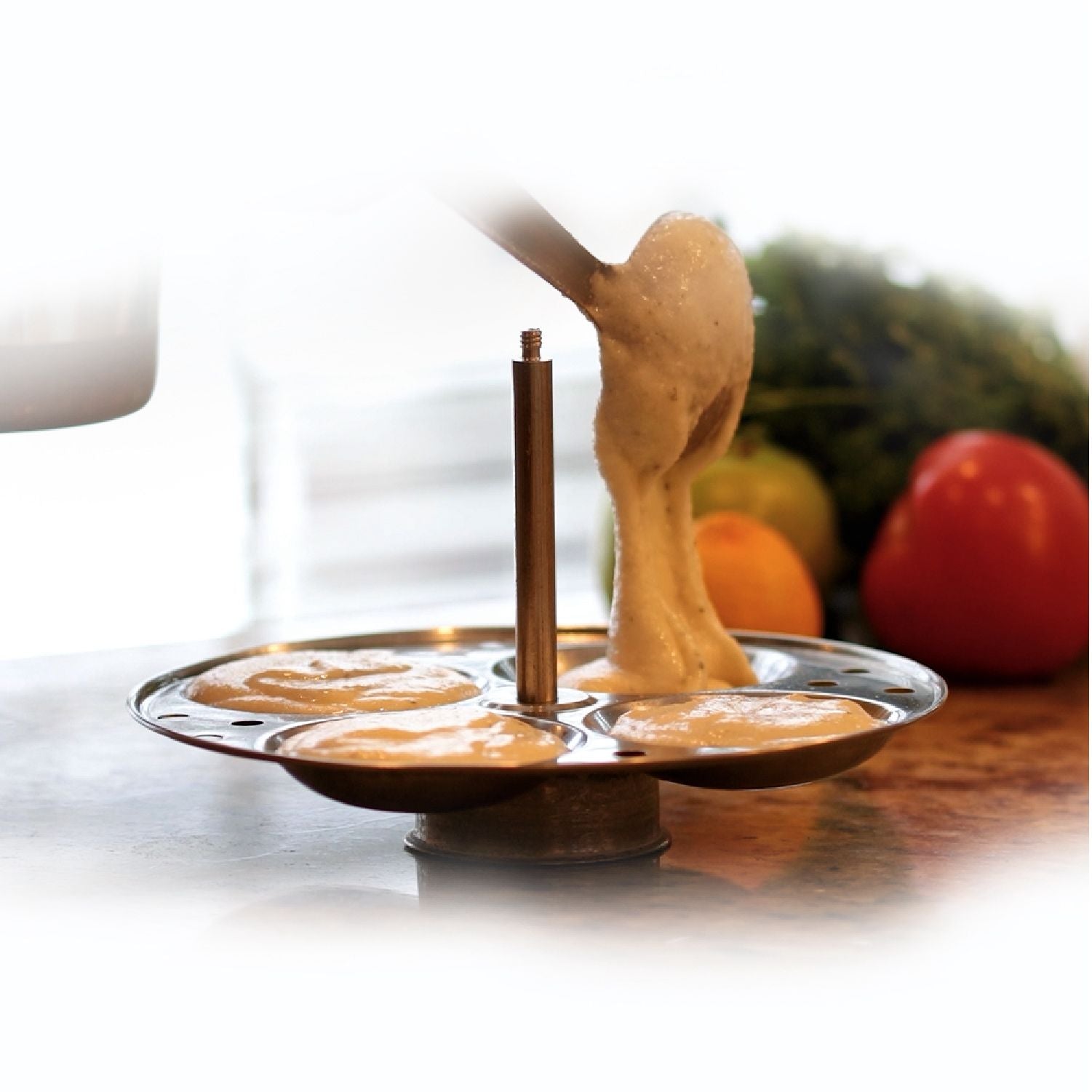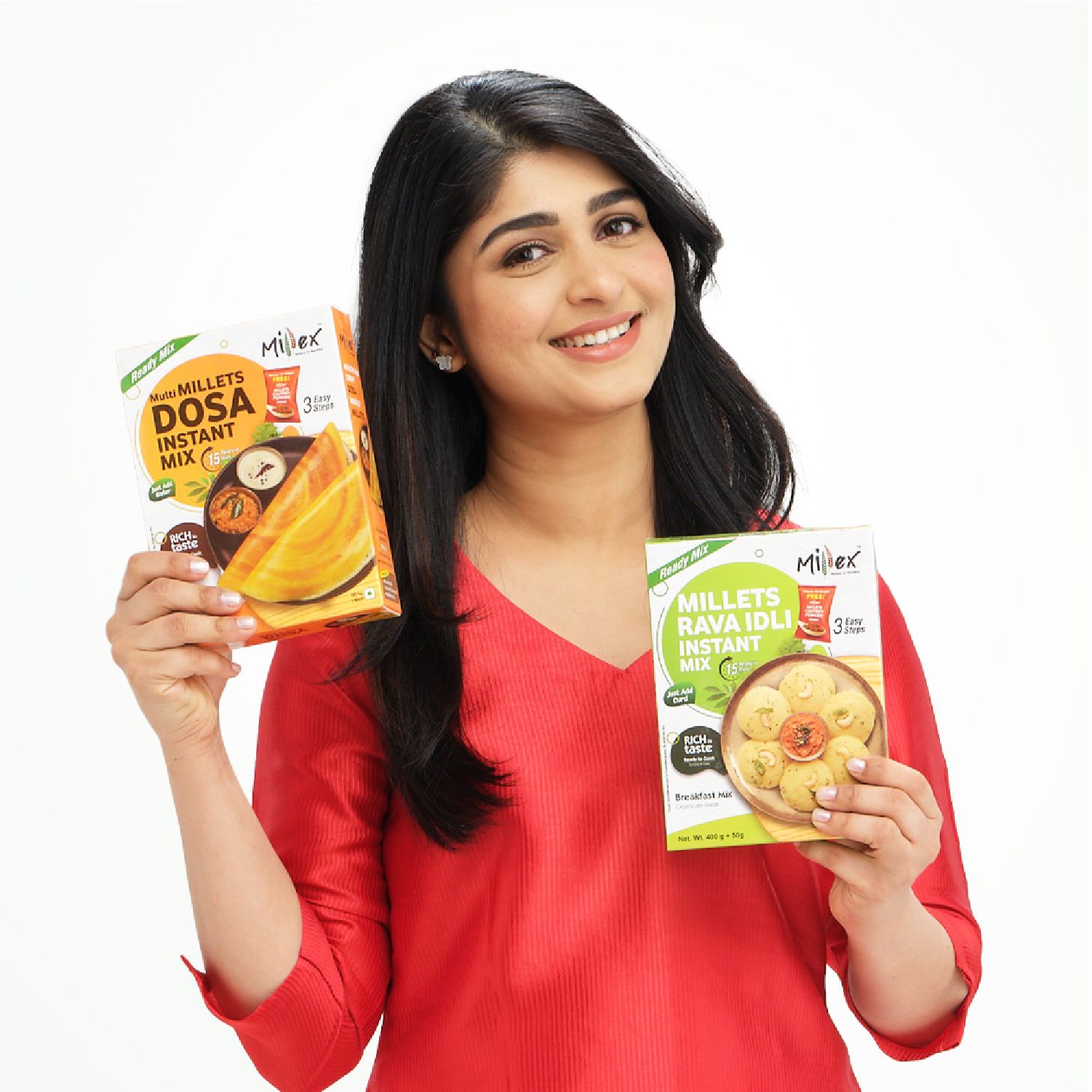Choosing the right grain for your daily diet can make all the difference in your overall health. Rice has long been a staple in many diets. But Ragi is rapidly gaining attention among people for its excellent nutritional value. Both grains offer unique benefits, but when it comes to Ragi vs rice for weight loss, Ragi stands out as the better choice. With its higher protein, fiber and nutrient density, Ragi helps maintain a balanced diet while promoting better digestion and supporting weight management.
At Millex, we offer various ready-to-cook millet products. This includes nutrient-dense ragi options. Our instant millet mixes, including Ragi-based recipes like Ragi Idli Instant Mix, Sprouted Ragi Masala Dosa Mix, are specially designed for convenience and balanced nutrition. They provide a quick and healthy way to enjoy the benefits of millet, which is packed with essential nutrients, vitamins, and fiber. In this post let us explore the comparisons to help you make the right decision.
 BUY NOW
BUY NOW
Understanding Rice
Rice is a commonly consumed grain worldwide. It is a central part of cuisines in Asia, Latin America and even Europe. Rice comes in various types. It includes white rice, brown rice and others. Each type offers a slightly different nutritional profile.
Nutritional Value of Rice
- Calories and Carbohydrates
Rice is primarily made up of carbohydrates especially white rice. This helps provide the body with energy. A 100 gram serving of cooked white rice contains about 130 calories, 28 grams of carbohydrates and very little protein or fat. Brown rice is the more nutritious variety. It has slightly higher fiber and protein content. But it still remains largely carbohydrate-heavy.
- Vitamins and Minerals
Rice is a good source of B vitamins, especially thiamine and niacin. These are important for energy production and metabolism. However, rice lacks several essential vitamins and minerals that the body needs for proper functioning.
- Fiber Content
White rice is stripped of its bran and germ during the refining process. This results in a product with very little fiber content. In contrast, brown rice retains its bran and germ. It offers more fiber, which aids in digestion and helps maintain steady blood sugar levels.
For a fiber-rich, nutrient-packed alternative, try Millex's Ragi Dosa Instant Mix, a convenient and healthy way to enjoy the benefits of millets. This is packed with essential nutrients and high in fiber, it is the perfect addition to your balanced diet.
Drawbacks of Rice
Rice is certainly a nutritious food when consumed in moderation. But there are a few reasons why it might not be the best choice for daily consumption:
- High Glycemic Index
Rice has a very high glycemic index, particularly white rice. This means that it causes a rapid spike in blood sugar levels. Consistently consuming high-GI foods can contribute to insulin resistance and weight gain and increase the risk of developing type 2 diabetes.
- Low Nutrient Density
Although rice contains some essential nutrients, it does not offer a wide range of vitamins, minerals and antioxidants. Over-reliance on rice as a daily food can lead to nutrient deficiencies.
- Lack of Fiber
The low fiber content in white rice means that it can lead to poor digestion, constipation and irregular bowel movements. Brown rice is better in this regard but still falls short compared to other whole grains like ragi.
What is Ragi?
Ragi is a highly nutritious grain that has been cultivated in India, Africa and parts of Southeast Asia for centuries. This small, reddish-brown grain is packed with essential nutrients. This makes it an excellent option for those looking to improve their overall health.
Can Ragi replace rice in daily meals? The answer is yes. Ragi can easily replace rice in your daily meals, offering superior nutritional benefits. This includes higher fiber, protein and essential vitamins and minerals.
Nutritional Value of Ragi

- Calories and Carbohydrates
Ragi is also carbohydrate-rich. This provides a good source of energy. However, it has a much lower glycemic index compared to rice. This makes it an excellent option for managing blood sugar levels. A 100-gram serving of Ragi contains approximately 336 calories and 72 grams of carbohydrates, which is comparable to rice. But it is packed with additional nutrients that rice lacks.
- High in Protein
Ragi is an excellent source of plant-based protein. It contains about 7 grams of protein per 100 grams. This is significantly higher than rice. It makes Ragi an ideal choice for vegetarians and those looking to build or repair muscle mass.
For a protein-packed, convenient meal, try Millex's Millet Ragi Idli Instant Mix. It offers a healthy, easy-to-make option to fuel your body with the benefits of millet and ragi in your busy schedule.
- Rich in Fiber
One attractive feature of Ragi is its high fiber content. This makes it a great option among fiber-rich foods for daily diet. A 100-gram serving of Ragi provides about 3.6 grams of fiber, which is much higher than rice. The fiber helps improve digestion, regulate bowel movements and contribute to feeling full longer. Ragi's high fiber content is especially beneficial for people with digestive issues or those trying to manage their weight.
- Vitamins and Minerals
Ragi is packed with essential vitamins and minerals that rice lacks. It is a rich source of calcium, which is crucial for bone health and preventing osteoporosis. It also contains iron, which is important for preventing anemia, as well as magnesium, phosphorus and B vitamins. These play vital roles in energy production, metabolism and overall health.
- Antioxidants
Ragi is a good source of antioxidants. This helps fight free radicals in the body, reducing oxidative stress and the risk of chronic diseases like heart disease, cancer and diabetes.
The Health Benefits of Ragi
- Better Blood Sugar Control
Ragi has a low glycemic index, making it a great option for people with diabetes or those at risk of developing it. When considering Ragi or rice for diabetes, Ragi is the superior choice. The slow-release carbohydrates in Ragi prevent spikes in blood sugar levels. It offers better control over glucose levels compared to rice. This makes Ragi an ideal grain for those managing diabetes, as it helps maintain steady blood sugar levels throughout the day.
- Weight Management
Ragi's high fiber and protein content make it an excellent choice for weight management. The fiber helps you feel full longer, preventing overeating, while the protein supports muscle growth and repair, contributing to a more efficient metabolism.
- Improved Digestion
Ragi is rich in dietary fiber. This aids in digestion and prevents constipation. Its fiber content also promotes the growth of healthy gut bacteria, improving gut health and boosting immunity.
- Bone Health
One of the key reasons for switching from rice to Ragi is its calcium content. Ragi is one of the best plant-based sources of calcium, essential for maintaining strong bones and preventing conditions like osteoporosis, especially in growing children and the elderly.
- Anemia Prevention
Ragi contains significant amounts of iron, which is vital for red blood cell production. Iron deficiency is a common cause of anemia. So, consuming Ragi can help prevent this condition and promote overall health.
- Better Heart Health
The antioxidants and healthy fats in Ragi help manage cholesterol levels and reduce the risk of heart disease. Additionally, the magnesium content in Ragi helps regulate blood pressure, contributing to better cardiovascular health.
For a heart-healthy meal that is also delicious and easy to prepare, try Millex's Multi Millets Upma Mix. You can prepare this instantly without any need for complex procedures, and it saves you time.
How to Incorporate Ragi into Your Daily Diet
Adding Ragi to your diet is easy. There are several ways to incorporate Ragi into your diet:
- Ragi Porridge
This is a popular breakfast dish made by cooking Ragi flour with water or milk. It is nutritious, quick and easy to prepare. This makes it a great start to your day.
- Ragi Roti
You can make flatbreads or rotis using Ragi flour. Choose to pair it with your favorite vegetables or curries for a healthy meal.
- Ragi Flour for Baking
Ragi flour can be used in baking to make cakes, cookies and muffins. You can substitute it for part or all of the flour in many recipes.
- Ragi Snacks
There are several ready-to-eat Ragi-based snacks available in the market. This includes Ragi biscuits, chips and granola bars. These are a healthy and convenient option for snacking.
- Ragi Drink
This is a traditional drink made with Ragi flour, water and sweeteners like jaggery or honey. It is a great refreshing beverage to consume throughout the day.
Check Out Millex and get your favorite Ragi Product today!
Rice remains a widely consumed staple in many diets. But Ragi clearly stands out as a far superior choice for daily consumption. It offers a wealth of benefits that rice simply cannot match, making it the ideal choice for those seeking a more balanced and nutrient-dense grain. Additionally, Ragi serves as one of the top gluten-free alternatives to rice, making it an ideal choice for individuals with gluten sensitivities or those following a gluten-free lifestyle.
At Millex, we offer a range of ready-to-cook millet products, including Ragi-based mixes like Ragi Idli Instant Mix and Sprouted Ragi Masala Dosa Mix. We also offer other millet products like Millet Rava Idli Instant Mix, Millex Mother Root, and more. These convenient, nutritious options make it easy to incorporate Ragi into your daily meals, helping you take full advantage of its health benefits. Visit our website to explore our collection and start adding the goodness of Ragi to your diet today.






